Top Rankings
Waynesboro City School District ranks among the top 20% of public school district in Virginia for:
Category
Attribute
Diversity
Most diverse schools (Top 1%)
For the 2025 school year, there is 1 public preschool serving 195 students in Waynesboro City School District.
Public Preschools in Waynesboro City School District have a diversity score of 0.72, which is equal to the Virginia public preschool average of 0.72.
Minority enrollment is 58% of the student body (majority Hispanic), which is more than the Virginia public preschool average of 56% (majority Hispanic and Black).
Overview
This School District
This State (VA)
# Schools
7 Schools
1,059 Schools
# Students
3,060 Students
522,218 Students
# Teachers
216 Teachers
37,218 Teachers
Student : Teacher Ratio
14:1
14:1
District Rank
Waynesboro City School District, which is ranked within the bottom 50% of all 135 school districts in Virginia (based off of combined math and reading proficiency testing data) for the 2020-2021 school year.
The school district's graduation rate of 81% has decreased from 86% over five school years.
Overall District Rank
#112 out of 135 school districts
(Bottom 50%)
(Bottom 50%)
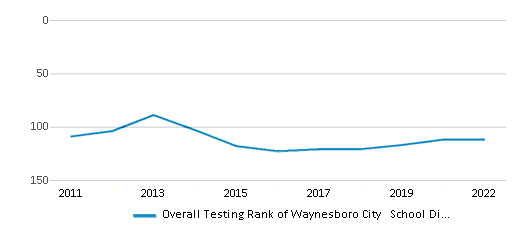
Math Test Scores (% Proficient)
(20-21)35%
54%
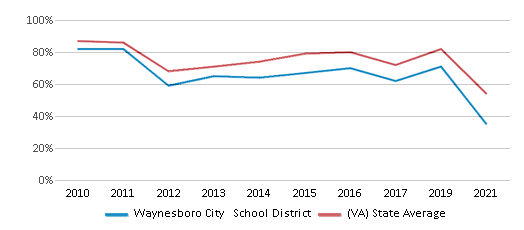
Reading/Language Arts Test Scores (% Proficient)
(20-21)57%
69%
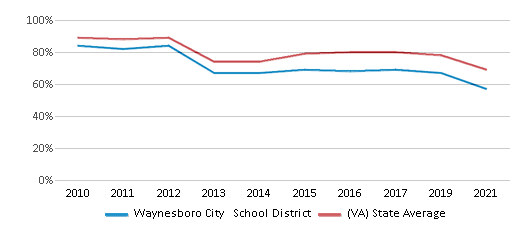
Science Test Scores (% Proficient)
(20-21)45%
59%
Graduation Rate
81%
89%
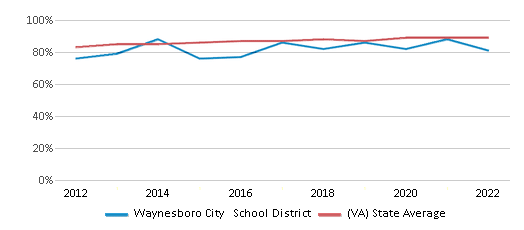
Students by Ethnicity:
Diversity Score
0.69
0.72
# American Indian Students
3 Students
1,435 Students
% American Indian Students
n/a
n/a
# Asian Students
53 Students
42,355 Students
% Asian Students
2%
8%
# Hispanic Students
648 Students
104,836 Students
% Hispanic Students
21%
20%
# Black Students
559 Students
103,630 Students
% Black Students
18%
20%
# White Students
1,473 Students
231,144 Students
% White Students
48%
44%
# Hawaiian Students
7 Students
693 Students
% Hawaiian Students
n/a
n/a
# Two or more races Students
317 Students
38,125 Students
% of Two or more races Students
11%
8%
Students by Grade:
# Students in PK Grade:
195
34,291
# Students in K Grade:
209
76,338
# Students in 1st Grade:
235
80,198
# Students in 2nd Grade:
233
82,775
# Students in 3rd Grade:
206
74,941
# Students in 4th Grade:
245
76,158
# Students in 5th Grade:
196
74,304
# Students in 6th Grade:
202
13,434
# Students in 7th Grade:
212
1,615
# Students in 8th Grade:
210
653
# Students in 9th Grade:
246
1,849
# Students in 10th Grade:
259
1,917
# Students in 11th Grade:
215
1,904
# Students in 12th Grade:
197
1,841
# Ungraded Students:
-
-
District Revenue and Spending
The revenue/student of $15,421 in this school district is less than the state median of $15,502. The school district revenue/student has stayed relatively flat over four school years.
The school district's spending/student of $14,209 is less than the state median of $15,257. The school district spending/student has stayed relatively flat over four school years.
Total Revenue
$47 MM
$19,496 MM

Spending
$44 MM
$19,187 MM
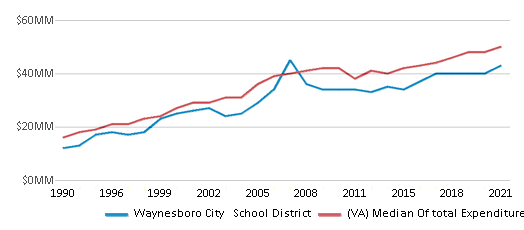
Revenue / Student
$15,421
$15,502
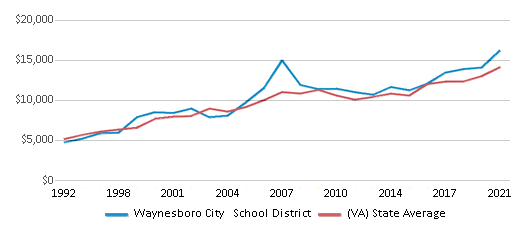
Spending / Student
$14,209
$15,257

Best Waynesboro City School District Public Preschools (2025)
School
(Math and Reading Proficiency)
(Math and Reading Proficiency)
Location
Grades
Students
Rank: n/an/a
937 Fir Street
Waynesboro, VA 22980
(540) 946-4626
Waynesboro, VA 22980
(540) 946-4626
Grades: PK
| 195 students
Recent Articles

Year-Round Or Traditional Schedule?
Which is more appropriate for your child? A year-round attendance schedule or traditional schedule? We look at the pros and cons.

Why You Should Encourage Your Child to Join a Sports Team
Participating in team sports has a great many benefits for children, there is no doubt. In this article you will learn what those benefits are.

White Students are Now the Minority in U.S. Public Schools
Increasing birth rates among immigrant families from Asia and Central and South America, combined with lower birth rates among white families, means that for the first time in history, public school students in the United States are majority-minority. This shift in demographics poses difficulties for schools as they work to accommodate children of varying language abilities and socio-economic backgrounds.





